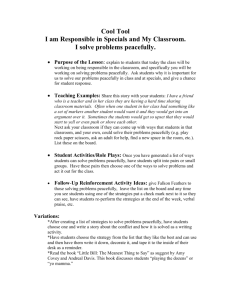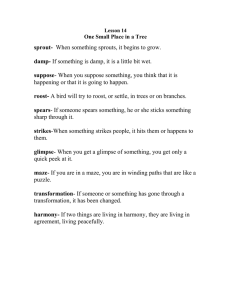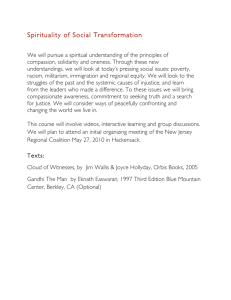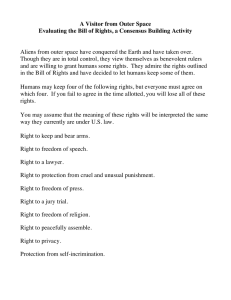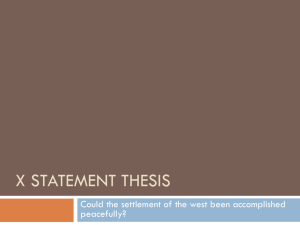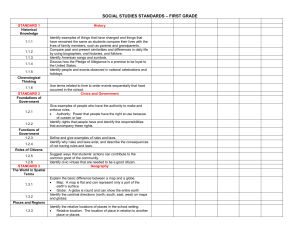SOLVES PROBLEMS PEACEFULLY
advertisement
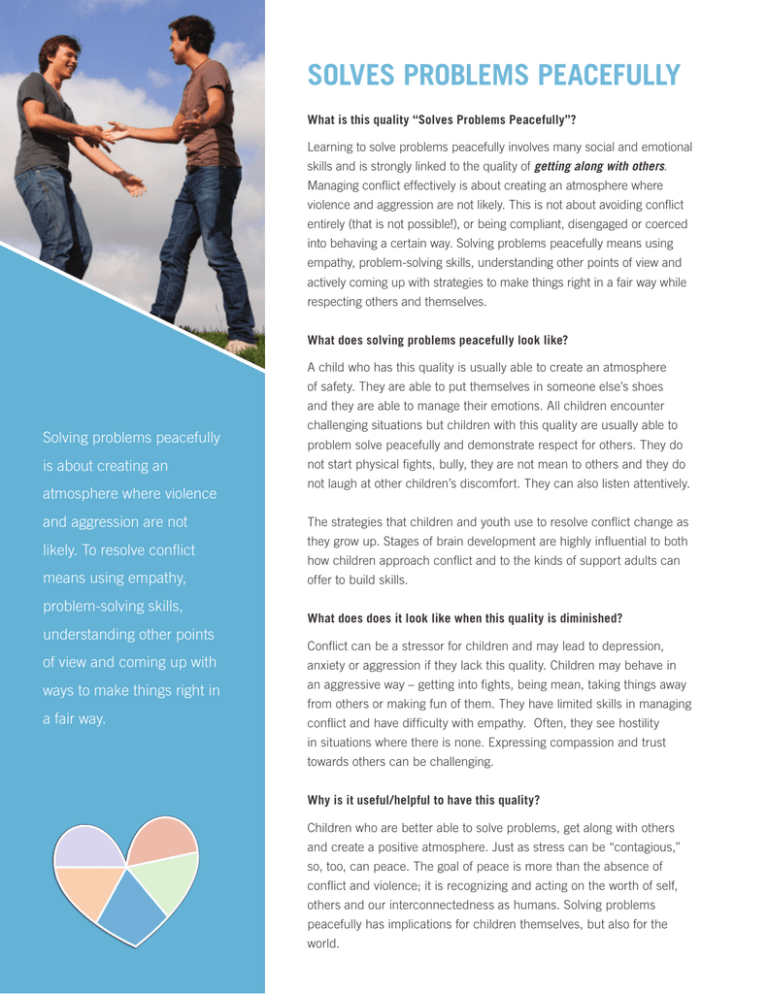
SOLVES PROBLEMS PEACEFULLY What is this quality “Solves Problems Peacefully”? Learning to solve problems peacefully involves many social and emotional skills and is strongly linked to the quality of getting along with others. Managing conflict effectively is about creating an atmosphere where violence and aggression are not likely. This is not about avoiding conflict entirely (that is not possible!), or being compliant, disengaged or coerced into behaving a certain way. Solving problems peacefully means using empathy, problem-solving skills, understanding other points of view and actively coming up with strategies to make things right in a fair way while respecting others and themselves. What does solving problems peacefully look like? A child who has this quality is usually able to create an atmosphere of safety. They are able to put themselves in someone else’s shoes and they are able to manage their emotions. All children encounter Solving problems peacefully is about creating an atmosphere where violence and aggression are not likely. To resolve conflict means using empathy, problem-solving skills, understanding other points challenging situations but children with this quality are usually able to problem solve peacefully and demonstrate respect for others. They do not start physical fights, bully, they are not mean to others and they do not laugh at other children’s discomfort. They can also listen attentively. The strategies that children and youth use to resolve conflict change as they grow up. Stages of brain development are highly influential to both how children approach conflict and to the kinds of support adults can offer to build skills. What does does it look like when this quality is diminished? Conflict can be a stressor for children and may lead to depression, of view and coming up with anxiety or aggression if they lack this quality. Children may behave in ways to make things right in an aggressive way – getting into fights, being mean, taking things away a fair way. conflict and have difficulty with empathy. Often, they see hostility from others or making fun of them. They have limited skills in managing in situations where there is none. Expressing compassion and trust towards others can be challenging. Why is it useful/helpful to have this quality? Children who are better able to solve problems, get along with others and create a positive atmosphere. Just as stress can be “contagious,” so, too, can peace. The goal of peace is more than the absence of conflict and violence; it is recognizing and acting on the worth of self, others and our interconnectedness as humans. Solving problems peacefully has implications for children themselves, but also for the world. 8 Actions that Promote SOLVING PROBLEMS PEACEFULLY Strengthen The part of the brain that is key to reasoning, problem solving, Give your brain a workout. comprehension, impulse-control, creativity and perseverance is the prefrontal cortex. This area is needed when we have to focus and think, mentally play with ideas, use our short-term working memory, and think before reacting in any situation. Things that stimulate this part of the brain include hugs, sports, play, volunteering, gratitude, sleep and juggling! Teach Teach children step-by-step strategies to approach conflict or deal with Teach children basic problem misunderstandings. solving steps 1. How do you feel? 2. What is the problem? 3. Come up with solutions. 4. What would happen if…? 5. Try the solution. Identify Include a discussion of feelings and emotions when examining a challenge Name the emotions that come up in or conflict. Appreciate that it is ok to have different emotions, and it is conflict. important to acknowledge other people’s feelings - try walking in their shoes. Restore During relationship challenges, ask how they would handle it differently Think of ways to restore situations of next time. Brainstorm ways to help restore the situation. Over time, these conflict or hurt. skills are internalized and they learn to do it for themselves! Wait In times of conflict children have opportunities to learn how to negotiate Avoid rescuing children from all relationships with others. Problem-solving takes practice so rather than conflict and offer the support to jump in and tell a child or adolescent how they should solve the problem, solve problems on their own. give them space to generate ideas and guide them through a process of evaluating possible solutions, and to imagine positive outcomes. Accept Even when children don’t solve problems in ways that align with how they Help children see difficulties as want to be as a person, teach them that they can always ‘go back’ (e.g., learning opportunities rather than apologize, talk through the situation etc.) and try again in order to resolve failures. problems in a way that leads them to feel better, and achieve higher levels of competence in solving problems. Support Being in conflict makes people feel vulnerable. Children who feel safe Create caring environments and can more easily trust both others and their own feelings during a problem relationships so that children feel solving and restorative process. loved and supported. Observe Take advantage of everyday situations, stories in the news, books and See and take on other perspectives. other media to help children understand how to take on other people’s perspectives.
